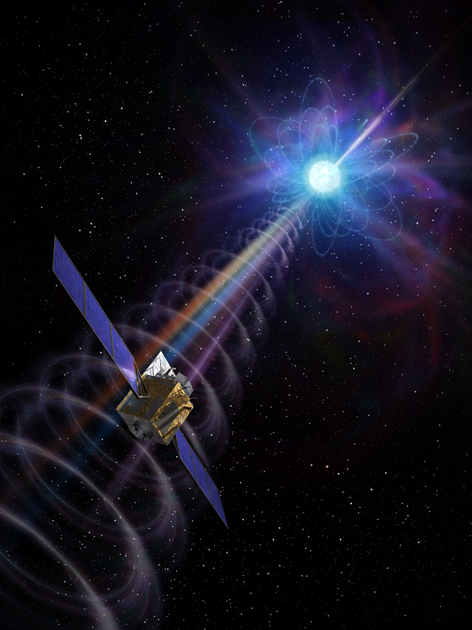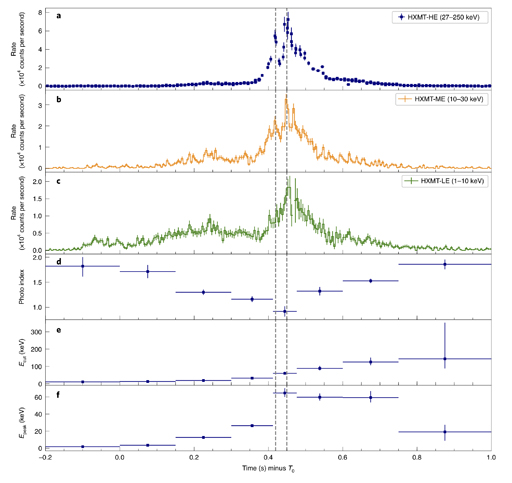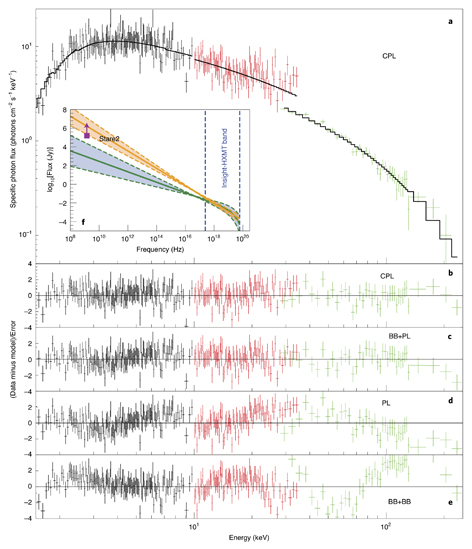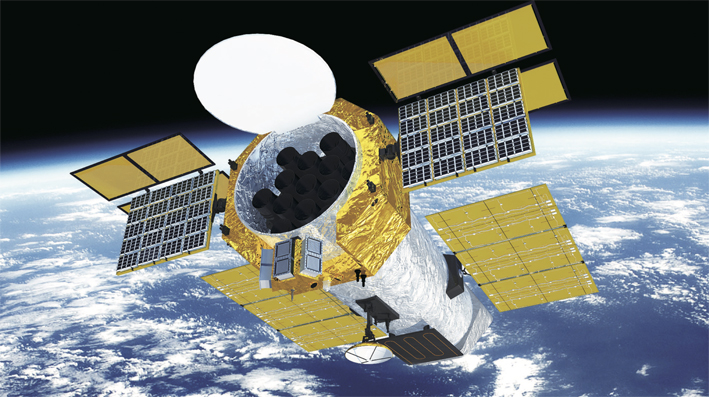-- Insight-HXMT and Its Identification of the Sender of FRB 200428, a Cosmic “Telegram”
By SONG Jianlan

Insight-HXMT, an astronomical satellite of China working in a very broad X-ray waveband, has helped identify a magnetar as the long-sought-after sender of a fast radio burst. Shown is an artistic illustration for this scenario. (Image credit: IHEP)
Fast radio bursts (FRBs), pulses of brief but extremely bright radio waves blasting from the depth of the cosmos, particularly those repeatedly erupting, have been fascinating astronomers and, astronomical amateurs as well, since their first discovery in 2007. What are they? What, or WHO, are behind these mysterious signals? Could it be a desperate telegram sent by an alien civilization seeking cosmic counterparts smart enough to decipher their message? Unfortunately, such bursts endure only milliseconds and hence are far too brief to allow closer astronomical observation and examination. About their origins, there exist even more theories than observed FRBs, just as a joke goes among astronomers to describe the smorgasbord of models attempting to explain their birth and propagation.
A majority of these theories suggest magnetars – highly magnetized neutron stars newly born from some catastrophic events like supernovae – as promising producers of such radio pulses. They are known to be sources of high-energy radiations like gamma rays and X-rays, and some models predict that young magnetars can give off radio bursts aside from gamma- and X-rays, however, no such radio burst had ever been directly detected from them. On the other hand, nor had any burst been detected from other wavebands in coincidence with any FRB, leaving their origin an enigma.
Long-awaited Evidence
The situation did not change until very lately when the results from a wave of coordinated observations occurring in late April of 2020 eventually got published in succession. These observations, focused on the same soft gamma ray repeater named SGR J1935+2154, known as a magnetar from our Milky Way, altogether helped associate FRBs with magnetars for the first time. Observatories across the world, ground- or space-based, working from different locations and wavebands – gamma rays, X-rays and radios, eventually close the long-existing gap, and partially solve the enigma of FRB origin.
Among them, the observation conducted by a team with the Hard X-ray Modulation Telescope (dubbed “Insight” and here later referred to as Insight-HXMT), an astronomical satellite of China, has offered data of the best quality from an unprecedented broad energy range for wavelengths of X-rays, as well as very accurate localization of the source. For the very first time, it unambiguously identified an X-ray burst from SGR J1935+2154 as the counterpart of FRB 200428, demonstrating that at least some FRBs are produced by magnetars.
Two space observatories, the Neil Gehrels Swift Observatory and the Fermi Gamma-ray Space Telescope first detected some bursts – in X- and gamma-ray bands – from SGR J1935+2154 on April 27, 2020. The source fell into the view of ground-based telescopes located in the Western Hemisphere the following day, and two radio telescopes, namely the Canadian Hydrogen Intensity Mapping Experiment (CHIME) and the Survey for Transient Astronomical Radio Emission 2 (STARE2) in the United States, detected a radio burst from the same direction as the magnetar SGR J1935+2154. The burst was later named as FRB 200428 after the date it was detected.
During the outburst of FRB 200428, several space observatories reported the reception of an X-ray burst from SGR J1935+2154, including the European Space Agency’s International Gamma-Ray Astrophysics Laboratory (INTEGRAL) space telescope, the Italian Astro-rivelatore Gamma a Immagini LEggero (AGILE) satellite, Russia’s Konus detector aboard NASA’s Wind spacecraft and, Insight-HXMT.
Targeting on the same object SGR J1935+2154, part of the results got published in Nature last November, immediately triggering a new wave of hot debate on physical mechanisms of FRBs. The Insight-HXMT team, led by Prof. ZHANG Shuangnan from the Institute of High Energy Physics (IHEP), Chinese Academy of Science (CAS), finally published their results in Nature Astronomy at sharp 12 am (GMT+8) on February 19, 2021. With the long-awaited direct observational evidence, the team identified the magnetar SGR J1935+2154 as the counterpart of FRB200428, finally unveiling the sender of this cosmic “telegram”.
Highlighted in the lightcurve recorded by the Insight-HXMT team are two steep peaks separated by an interval of arrival time measuring about 34 milliseconds; this twin sub-burst is broadly consistent with the 29 milliseconds interval between the two narrow peaks in FRB200428 as recorded by the teams working with CHIME and STARE 2. Moreover, the apparent time delay between the X-ray signals recorded by the Insight-HXMT and the radio peaks captured by CHIME and STARE2 is also in excellent agreement with the dispersion delay predicted by theoretical calculation.

Shown here are the lightcurves of the X-ray burst from SGR J1935+2154 as observed by Insight-HXMT, covering the whole duration of this burst in coincidence with the radio burst of FRB 200428. Highlighted is the twin sub-burst with a 34-millisecond separation in arriving time of signal. The refined structure, in excellent consistency with the twin peak detected in the radio burst detected by CHIME and STARE2, unambiguously confirms the association between the two. (Credit: IHEP)
The team also gave the localization of the X-ray burst, at an accuracy far better than STARE2 and CHIME, two ground-based radio telescopes. The location is perfectly consistent with the previously known position of the magnetar SGR J1935+2154 in the sky. Given that SGR J1935+2154 was the only active magnetar at the time of observation falling in the small localization region within the field of view of Insight-HXMT, the team unambiguously identified that the short X-ray burst “was emitted by the Galactic magnetar SGR J1935+2154 and produced almost simultaneously with FRB 200428 in a single explosive event.”

The accurate localization (white contours at the center of the inset) given by Insight-HXMT of the source SGR J1935+2154 (the red cross on the left) coincident with FRB 200428, in comparison with those given by STARE 2 (the dot-line circle on the left) and CHIME (the red circle on the left, also shown in the inset). (Credit: IHEP)
The team does not exclude the possibility of other origins for the majority of FRBs, however.
“For the burst we caught with Insight-HXMT, we would say it is very unlikely to have been sent by an alien,” concludes ZHANG Shuangnan, principal scientist of the telescope, in a humorous tone when inquired of the possibility. “The gravity and magnetic fields of magnetars are extremely strong,” he explains, “too strong for any life to survive.”
Its gravity is so strong that the gravitational pull between two points in a very tiny distance could be extremely large – any object there would be ripped apart by the intense action introduced by this difference, or tidal dynamics. The magnetic field on the surface of a magnetar can go as strong as about 1.0×108 Tesla or even larger. As a sharp contrast, the magnetic field of our home planet, the Earth, is much milder, roughly ranging from 3.5×10-5 Tesla around the equator to 7.0×10-5 Tesla in the polar regions on the surface.
“Atypical” Telegram Sender
It might not be typical for magnetars to burst out both X-rays and radio pulses, however.
When analyzing the data, the team fitted different models and found out that the spectrum follows a cutoff power-law model the best, with an acceptable statistical reliability. Based on this, they concluded that the integrated spectrum could be dominated by a power law covering at least the 1?100-keV energy range, which means, this burst is primarily non-thermal in nature.

Covering an energy band from 1 to 250 keV, the spectrum observed with Insight-HXMT follows a cutoff power law model the best, indicating its unusual nature in terms of physical mechanism. (Credit: IHEP)
“Magnetar outbursts are mostly thermal, therefore this burst is rare for magnetars,” explains Prof. XIONG Shaolin, ZHANG’s IHEP colleague and coauthor of the paper. “Non-thermal spectra are believed to be related to high-energy particles. However, how the particles are accelerated to this high energy is still not clear.” “On the other hand, radio pulses are of non-thermal nature,” adds ZHANG Shuangnan, “and this may explain why the X-ray burst came together with a radio pulse. Concerning the acceleration of particles, either an electric field or a magnetic field can do the job. It is very interesting an issue to explore.”
Models for magnetar origin of FRBs roughly fall into two categories, one attributing the FRB emission to coherent curvature radiation of electron-positron pairs from the magnetosphere of the magnetar, while the other attributing it to the synchrotron maser emission produced by a relativistic, magnetized shock. Given that the double peaks appear in both X-ray and radio parts of the spectrum are structurally consistent, they are very likely produced by the same explosion; if the hard X-ray part of the spectrum is more likely to be produced in the magnetosphere, it lends more support to the magnetospheric category of models, analyzed the Insight-HXMT team in the Nature Astronomy paper.
Generally, normal short bursts from magnetars are of thermal origin, as the Insight-HXMT team reported in their paper. They gave a conservative estimate that at the most only 6% of magnetar bursts would give similar radio emissions as FRB 200428. This rarity might also explain why such events had not been seen before, they analyzed.
“Making a detectable FRB from SGR bursts requires contrived conditions. The success rate is at most one out of a hundred,” comments Dr. ZHANG Bing from the Department of Physics and Astronomy, University of Nevada, Las Vegas, the USA. Reviewing the two generic categories of radiation models concerning magnetar origin of FRBs, he states: “Magnetars could be the common source for both models.”
Observations by another observatory of China, the Five-hundred-meter Aperture Spherical radio Telescope (FAST), also indicates that it might be a very rare case where a magnetar emits both X-rays and radio waves. From April 15 to 28, a team at the National Astronomical Observatories, Chinese Academy of Sciences (NAOC) used the FAST to make an eight-hour targeted observation on the same source SGR J1935+2154 and 29 soft-gamma-ray repeater (SGR) bursts happened during the third session of their observation.
Unfortunately, they were not observing when the FRB 200428 came. They did not detect any single dispersed pulsed emission coincident with the arrivals of SGR bursts.
“Our results suggest that FRB-SGR burst associations are rare. … only under extreme conditions could an FRB be associated with an SGR burst,” they concluded in a paper published November 4, 2020 in Nature.
Therefore, how FRB emission is generated deserves further examination. How a magnetar drives an FRB as more general a case remains in clouds; moreover, whether or not celestial bodies other than magnetars can power FRBs are still open for exploration.
Rare Opportunity
“We could have missed out this very dear opportunity had not for Dr. LIN Lin,” stresses ZHANG Shuangnan with heartfelt appreciation. It was LIN who suggested ZHANG stop their ongoing observation and switch Insight-HXMT onto the magnetar SGR J1935+2154. Following LIN’s suggestion, at about 10 am on April 28, ZHANG gave instructions to the operation team to stop their ongoing observation and prepare for the new task. At 15:14:52 the same day, the system was tuned to the direction of SGR J1935+2154 for a target-of-opportunity observation.
LIN, co-first-author of the paper and currently a lecturer at the Beijing Normal University, began exploring into the high-energy bursts of magnetars when doing PhD under ZHANG’s supervision. “I’ve been observing this magnetar since 2014, analyzing the nature of its explosions,” says LIN when asked about the reason why she made the suggestion. “It is a highly active SGR source; basically, every year it breaks into an active phase – actually this month, just now, it is undergoing bursts. What was different for the outbreak in last April was,” she stresses, “it was unusually violent: its onset unleashed as many as several hundred bursts in just two minutes. This was really rare for magnetars. Therefore, I proceeded to urge both Insight-HXMT as well as FAST to focus on it.
“My suggestion got warm-hearted support from the teams. I was surprised that Prof. ZHANG offered me such a generous quota of observation time – he gave me over one whole day! I am so honored!” She recalls.
They did not wait too long to see the bursts from the magnetar. After several hours, at 22:34:24 on the same day, Insight-HXMT picked up a bright burst of X-ray from the source, with the two briefly separated steep peaks – which were later identified as the hard X-ray counterpart of the two peaks in the radio spectrum of FRB200428 as captured and recorded by multiple radio telescopes.
LIN’s foresight resulting from her observation and research in magnetars has helped bridge the gap between observations from two different wavebands which had been long isolated from each other.
“Old Idea” Proven Excellent
On the other hand, their discovery would not have been possible without Insight-HXMT, which works in an unprecedentedly wide energy range of X-rays, ranging from 1 to ~250 keV and higher.
The birth of this wide-band hard X-ray telescope shall be attributed to CAS Member Prof. LI Tipei, leading astrophysicist of China. It was LI and his colleague, Prof. WU Mei, who first initiated the idea of HXMT in 1993.
At that time X-ray astronomy was still young and by then no instrument for hard X-ray imaging had been developed in China. “Due to their high energy, beams of hard X-rays would not be reflected by a mirror,” explains LI. “They just resist bending. Therefore, it is very hard to make them focus on a point to produce a clear image of the source.” To solve this problem, he and WU proposed a mathematical algorithm, in the hope of building a space telescope for all-sky survey in hard X-ray bands.
They designed a smart system featuring 18 arrays of slat collimators, whose fields of view (FOVs) each are restricted into a narrow strip. These strips of FOVs are oriented differently with a step size of 60 degrees. When scanning the sky, the signals from the target would be modulated by the collimators to allow only those in certain directions through to get recorded for subsequent processing. Via complicated reverse algorithm, scientists can reconstruct the source of the signals and locate its direction on the sky. The FOVs scanning in different orientations will commonly constrain the object’s angular location in the sky, giving an accurate localization on the intersection of all FOVs.

(Left) Modules of the high-energy (HE) detector aboard Insight-HXMT and (Right) the corresponding fields of view (FOVs) of HE in combination with those of other two detectors aboard Insight-HXMT, the medium-energy (ME) and low-energy (LE) ones. The differently oriented FOVs commonly constrain and hence determine the localization of the target. (Credit: IHEP)
The advocates of the proposal sought to send this instrument into space to sample and map out the distribution of obscure supermassive black holes in the whole sky and establish a catalogue for active galactic nuclei (AGNs) as an essential tool for probing the extragalactic hard X-ray diffuse emission.
Unfortunately, their ambition was frustrated by the long delay in funding. The underlying algorithm, called direct modulation method, has been intensively controversial. Even today, lots of experts still maintain some caution about its validity in imaging and locating the observed object.
The proposal was not adopted by the authorities and officially funded until 2011. Well before then, the European mission INTEGRAL was launched in 2002 while the US mission Swift in 2004. The two missions took over their initial scientific objectives, and the AGN catalogue they envisioned was subsequently built.
The team upgraded the system with renewed core science and improved technologies. The renewed scientific objectives include observations of X-ray binary systems (in their bright states) or outbursts over a broad energy band. The orientations of the collimators are also optimized for Galactic plane scanning survey and monitoring, instead of all-sky surveys for AGNs. Before its launch, further development was made to enhance its all-sky monitoring capability to a wider energy range of 0.2~3 MeV.
Eventually, the telescope was sent into the near-Earth orbit 550 km above ground on June 15, 2017. It was later named “Huiyan” (meaning “eye with wisdom”) in Chinese, or Insight-HXMT, to honor late Chinese physicist, CAS Member Prof. HE Zehui, a founder of high-energy astrophysics of China.
Insight-HXMT did not let them down.
When it was still undergoing tests and in-orbit calibration, the satellite readily caught the trail of GW170817, the famous neutron-star binary that simultaneously gave off gravitational waves as well as electromagnetic signals. Hence it joined the unprecedented chorus of synchronized observations conducted by conventional astronomical telescopes as well as gravitational-wave observatories, the well-known LIGO II and VIRGO. With complete monitoring of the GW burst, the then newly launched satellite offered data of unique value at high energy with its large effective area and wide FOV. It was among the four X- or gamma-ray telescopes that monitored the GW source throughout the trigger time, and has reported the most stringent constraints to the emission at soft gamma-rays over different phases of the merger event.

While still being tested after its launching, Insight-HXMT joined the unprecedented chorus of observations conducted by both gravitational-wave detectors (LIGO II and VIRGO) and conventional telescopes working in electromagnetic wavebands. Its excellent sensitivity, wide field of view and broad waveband have offered high-quality data setting stringent constraints to the merger event GW 170817. (Credit: IHEP)
New Opportunity Dawning from Multi-wavelength Observation
“It is very critical work,” comments Prof. Maurizio Falanga, expert in high-energy astrophysics and head of the International Space Science Institute in Bern, Switzerland. “I am excited to see Insight-HXMT play such a fundamental role at this wavelength. The spectrum works very well, the data is perfect … unbelievable. No one was expecting that anyone could capture a burst of two peaks separated by a 34-millisecond interval with an instrument like Insight-HXMT, because the signal is too low. It made it… Perfect! It is one of the key instruments now working in the sky, in the high-energy band.
“It has been an open question whether FRBs are associated with magnetars; to solve it you need to link the spectra from different energy bands. Just like looking at a human body through optical lens you can only see skin deep, while through X-rays you can see the bones. Combining images from different ways you can get the whole picture.”
Falanga and collaborators led by Prof. LI Zhaosheng from the Key Laboratory of Stars and Interstellar Medium, Xiangtan University in Hunan Province of China are analyzing the spectral and timing characteristics of an X-ray pulsar integrating observational data from NICER, XMM- Newton, NuSTAR, INTEGRAL, Swift and Insight-HXMT obtained from 2018 to 2019. “Concerning what HXMT can do in potential
synchronized observations with telescopes in other energy bands, this research could make a beautiful example,” he says.
When hailing an era of multi-messenger astronomy, maybe it is also a good time to look at the convergence of observations from neighboring electromagnetic wavebands. Instead of a mosaic of mutually isolated strips, this convergence might offer a more “seamless” image of the inherently integrated cosmos.
ZHANG’s team is aiming big.
Targeted at scientific issues of extreme physics only possible to test or explore in the natural laboratory of cosmos, their proposal of a next-generation space-based astronomical observatory called the “enhanced X-ray Timing and Polarimetry” (eXTP) has been adopted by the CAS-sponsored Strategic Priority Program on Space Science for background study. It is expected to emerge as a large-scale international consortium involving over 20 countries, dedicated to research in black holes and neutron stars in great detail. This observatory will be a powerful successor for Insight-HXMT, though the latter is now in very good condition and seeing an extended service time.

The conceptual scheme of the enhanced X-ray Timing and Polarimetry (eXTP), a powerful successor of Insight-HXMT, though the latter is in very good condition and is seeing an extended service term. (Credit: IHEP)
Reference
1. C. K. Li et al. HXMT identification of a non-thermal X-ray burst from SGR J1935+2154 and with FRB 200428. Nature Astronomy https://doi.org/10.1038/s41550-021-01302-6
2. Bochenek, C. D. et al. A fast radio burst associated with a Galactic magnetar. Nature 587, 59–62 (2020).?
3. The CHIME/FRB Collaboration. A bright millisecond-duration radio burst from a Galactic magnetar. Nature 587, 54–58 (2020).
4. Mereghetti, S. et al. INTEGRAL discovery of a burst with associated radio emission from the magnetar SGR 1935+2154. Astrophys. J. Lett. 898, L29 (2020).
5. Lin, L. et al. No pulsed radio emission during a bursting phase of a Galactic magnetar. Nature 587, 63–65 (2020).?
6. A. Weltman & A. Walters. A fast radio burst in our own Galaxy. Nature 587, 43–44 (2020)
7. Lu et al. Hard X-ray imaging with a slat collimated telescope Nucl. Instr. and Meth. in Phys. Res. A 362, 551–555 (1995).
8. Zhang, S.-N. et al. Overview to the hard X-ray modulation telescope (Insight-HXMT) satellite. Sci. China Phys. Mech. Astron. 63, 249502 (2020).

